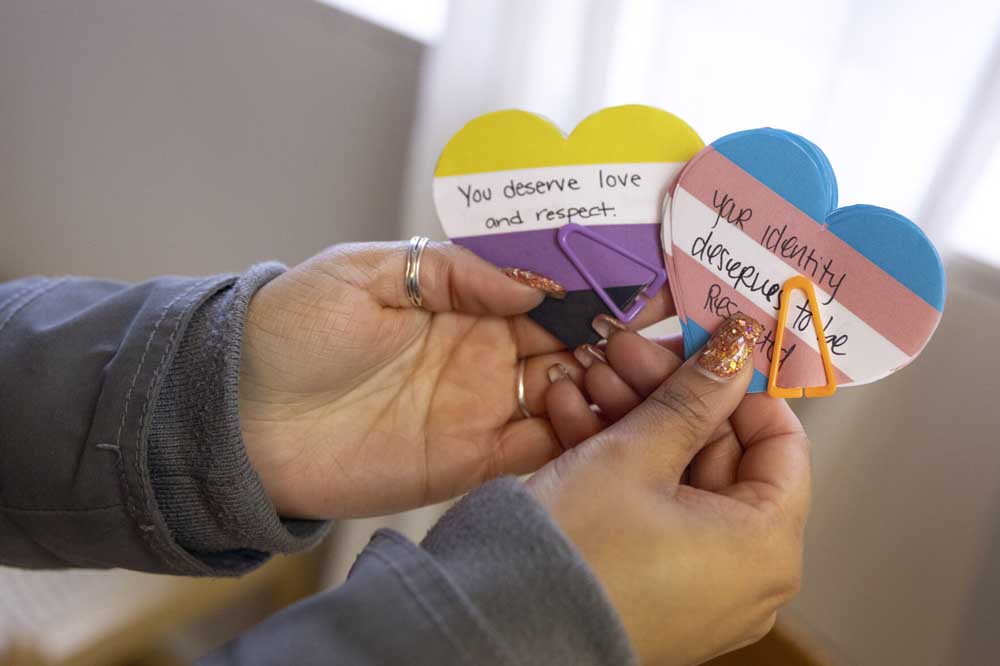The Dock offers a safe space for teens
Published 6:00 pm Sunday, November 24, 2024

- Alexia Smith, of The Harbor, holds up paper hearts with words of affirmation.
On a recent drizzly afternoon, Alexia Smith opened the doors to a small building tucked behind a row of food carts downtown.
Away from the blustery weather, the scent of candles filled the air, and a line of hanging lights cast a warm glow onto a set of armchairs and a sofa inside. Posters freckled the wall — a few boasting painted sailboats, and another reading “Consent is sexy” atop a multicolor backdrop.
The space, which reopened earlier this month, is meant for youth ages 13 to 18 — and to Smith, it’s filling an important gap.
“Coming here to a small town, I was really kind of shocked at the lack of resources and availability of things, especially for youth,” said Smith, co-director of services at The Harbor. “They need a place to go that’s safe, and I think it’s crucial, especially here.”
The Harbor is Clatsop County’s designated service provider for survivors of sexual assault and domestic violence. For the past several years, the Astoria nonprofit has discussed creating a youth space after receiving feedback from community partners identifying a need. After briefly opening in the spring, that space — called The Dock — is now back up and running.
“It’s a space where youth can just go and have a conversation with a trusted adult about whatever they want to if they need to, or where they can connect with peers and have similar conversations, or they can just go and have someplace to be that isn’t outside or isn’t somewhere where you have to spend money,” said Terri Steenbergen, The Harbor’s executive director.
The Dock is open for drop-in hours from 1 p.m. to 7 p.m. on Wednesdays and Thursdays. The room is sprinkled with evidence of the efforts being taken to create a welcoming environment — in one corner, hot cocoa packets and snacks fill a small kitchenette; along another wall, jeans and sweaters hang from a rack as part of the space’s free clothing closet; nearby, a stack of canvasses sends a reminder of a recent paint night.
“Having a space for children right down the road is kind of nice, and for teenagers,” said one participant, adding that they appreciated the goody bags and snacks available.
The Dock has hosted a range of events, from cookie decorating to a movie night. That work is just one piece in The Harbor’s broader outreach goals, though.
In 2020, The Harbor launched its comprehensive prevention programming — work that includes outreach in local schools and workshops for students covering topics like healthy relationships and consent. It also includes support for parents, partnerships with Tongue Point Job Corps Center and the Lower Columbia Q Center and collaboration with the Oregon Health Authority to create materials aimed at answering common questions from youth.
Often, Steenbergen said, one of the biggest factors in violence prevention is having a place for people to go.
“A big part of prevention is just having community connections, right?” she said. “It’s just bringing people together and making people feel included and making people feel supported. If you’re a young person with no friends or no family support, then you just kind of feel out there on your own, you’re much more likely to experience violence within your life or commit it.”
The Dock has two staff on-site at all times. As the space gains participants, Steenbergen said she’d love to see a youth support group emerge — but in the meantime, other events and activities also play an important role in prevention.
“You don’t actually have to be talking about consent or sexual violence prevention in order for it to be a prevention activity, right?” Steenbergen said. “It’s just like people spending time together, like with The Dock, and then also with some of these parenting programs that we’re doing, we’re (just) bringing parents together to have conversations. It’s not necessarily like the in-your-face talking about violence prevention. It’s more just like spending time and learning how to have conversations and be in relationship with each other and support each other.”
Back in an office off of the main room, Smith has created a grid of 8.5-by-11-inch papers on the near wall — a map of sorts of what the next few years of prevention work might look like, with ideas scribbled out in green Sharpie. One of those rows is dedicated to The Dock.
Eventually, the hope is to expand The Dock’s hours, but until then, they’re looking forward to welcoming more youth into the space two days a week. Turnout is still low, but that hasn’t hindered Smith’s enthusiasm.
She still remembers how it felt to open the doors for the first time.
“I was so excited,” Smith said.


